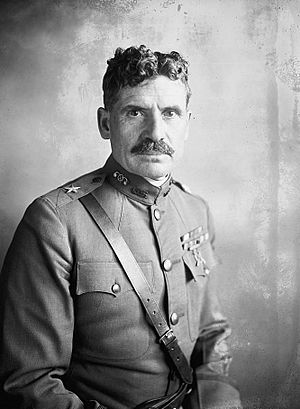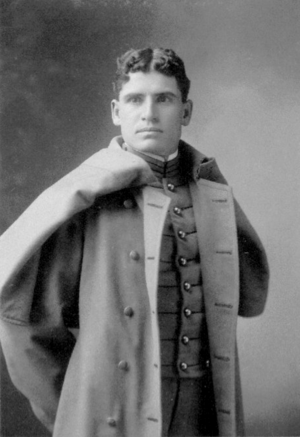Amos Fries facts for kids
Quick facts for kids
Amos A. Fries
|
|
|---|---|

Brig. Genl. A. A. Fries, August 5, 1921
|
|
| Born | March 17, 1873 Viroqua, Wisconsin |
| Died | December 30, 1963 (aged 90) Washington, D. C. |
| Place of burial | |
| Allegiance | United States of America |
| Service/ |
United States Army |
| Years of service | 1898–1929 |
| Rank | Major General |
| Commands held | 1st Gas Regiment, Chemical Warfare Service |
| Battles/wars | Philippine–American War World War I |
| Awards | Distinguished Service Medal |
| Other work | Author Road/Bridge construction – Yellowstone Park |
Amos Alfred Fries (1873–1963) was an important general in the United States Army. He graduated from the United States Military Academy in 1898.
Fries became the second chief of the army's Chemical Warfare Service. This group was created during World War I. Before that, Fries worked under General John J. Pershing in the Philippines. He also helped build roads and bridges in Yellowstone National Park. After retiring from the Army in 1929, Fries wrote books. He passed away in 1963 and is buried at Arlington National Cemetery.
Contents
Early Life
Amos Alfred Fries was born on March 17, 1873, in Viroqua, Wisconsin. His family moved to Missouri and then to Oregon. He earned a spot at the United States Military Academy. He finished his studies there in 1898.
Military Career
After graduating, Fries joined the Army Corps of Engineers. He served in the Philippines during the Philippine–American War. There, he fought alongside Captain John J. Pershing. Pershing later became a top commander in World War I.
From 1914 to 1917, Fries managed the building of roads and bridges in Yellowstone National Park. He became well-known for this work.
When World War I began, Fries went to Europe. He expected to continue engineering work. Instead, he was put in charge of the new Gas Service Section. This group included the 1st Gas Regiment. Fries commanded this section.
In 1919, he became the chief of the Overseas Division of the Chemical Warfare Service. The next year, he became the main chief of the Chemical Warfare Service. He held this job until he retired from the Army in 1929. For his work, he received the Distinguished Service Medal.
Views on Communism and Chemical Warfare
During the time between World War I and World War II, the Chemical Warfare Service kept its chemical weapons. This happened even though some people and presidents wanted to get rid of them. Fries believed that calls to remove chemical weapons were part of a Communist plan.
As the chief of the Chemical Warfare Service, Fries created a secret group. This group watched for people he thought were trying to cause trouble in the country. Fries said that some groups, like the National Council for Prevention of War, were linked to communism. He also made similar claims about Florence Watkins. She was a leader in the National Congress of Parent Teacher Associations. Because of Fries' claims, these groups stopped being members of the National Council for Prevention of War.
In 1923, Fries' office shared a "spider chart." This chart was given to groups that supported the country. It suggested that women's groups and church groups might be linked to radical groups and Communist leaders. The chart listed 21 women and 17 organizations. This included the Daughters of the American Revolution. Later in his life, Fries wrote two books against communism. These books were called Communism Unmasked (1937) and Sugar Coating Communism.
Later Life and Death
Fries passed away on December 30, 1963. He was buried at Arlington National Cemetery.
Selected Publications
- Chemical Warfare (1921), with Clarence J. West
- Communism Unmasked (1937)
- Sugar Coating Communism: A Plea for God and Country, Home and Family (c. 1930)
- Sugar Coating Communism for Protestant Churches: Chart Showing Interlocking Membership of Churchmen, Socialists, Pacifists, Internationalists, and Communists (chart – 1923)


